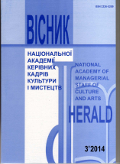THE NEW TENDENCIES OF THE PERFORMANCE OF PIECES BY J. S. BACH IN THE CHAMBER MUSIC CLASS
DOI:
https://doi.org/10.32461/2226-3209.3.2014.138117Keywords:
baroque, chamber music, historically-oriented performance, basso continuo, timing, articulation, ornamentationAbstract
The article describes new tendencies of interpretations of J.S. Bach’s music. It explains appearance of different
performing traditions and relations between historically-oriented and "academic" ways of performing. The article consists of examples and descriptions of various ways of performance and comparison between "authentic" and "modern" interpretations. Special attention turns timing and articulation as specific ways of historically-oriented style of playing.
Only selected baroque pieces are involved into chamber music repertoire. It’s connected with such a specific type of music making as basso continuo realization. This technique suggested ‘schematic’ writing of harmonic functions
by composer and active, creative role of performer who had to improvise and model fully ‘flourished’ music texture,
answering certain rules. Various époques and composers’ schools of various countries had their own ways of performance of basso continuo. Unfortunately, art of playing basso continuo was lost in academic performance tradition and revived just much later by enthusiasts of the authentic manner of performance. So, pieces using this technique naturally avoided chamber music repertoire. Bach sonatas for violin and harpsichord obbligato are one of those which are the part in the modern chamber music repertoire. Nowadays there is no certain tradition of playing Bach’s music. All famous performances show often very different interpretations. Differences concern character, genres, strokes, tempi, touché, timing etc. It happens because academic tradition of performance at the modern instruments, which had formed in the Soviet and Ukrainian art and also in the Western Europe, contradicts to the historically oriented tradition of performance at the instruments of the Bach’s époque, which had gained the wide popularity in the 2nd half of the XX century. We speak about the baroque violin and harpsichord. Newly found treatise, special High schools and High school’s departments concentrate on historically-informed performance. Besides Western Europe such schools are in Ukraine, in Baltic countries, Finland, Russia. Essential differences between the early instruments, particularly harpsichord, from the modern instruments, adapted for the modernt concert halls and demands of modern world, define the performance specific of these pieces. So we could distinguish authentic tradition, academic with ‘romantic’ accent or even the ‘compromise’ version, which combines ideas of both. We have to admit that for piano player this difference is very essential because of specific of the instrument. Harpsichord player is working with sound which has no dynamic gradations, so he must look for expressivenesses by timing and articulation, remembering the advice of Bach – to "sing on a harpsichord". In the same time obviously, that, so to say, an attempt to "sing" on piano can result to the displays of bad taste and to doubtful accordance to the style of the piece. In particular, it’s possible to make such an evident example: playing music of baroque on modern instruments, performers carefully work above the proper style, are looking for proper touché, similar to the early one.
Another polemic question is a question of ornaments. Due to scientific labours of theorists, treatises of that time
and Bach’s tables of decorations, there are certain rules of decoding signs of ornaments. But in the same time his works are full of exceptions, which depend on voices and require the real practical knowledge, which scarcely can be found in the generalized look in some literary source. It concerns, for example, parallelisms which sometimes appears between voices even following the rules of decoding. It requires flexible approach from a performer. In addition, a genre of the work influences substantially on interpretation of decorative patterns. In fact in the days of Bach two musical traditions had bright national originality: Italian and French. Their different etymology (vocal in first case and lute in the second) influenced both on the code of genres and on ornaments. German composer's school leaned on achievements of these schools both, and consequently came running to the use Italian and French genres in the same time. In accordance with it Bach’s works can be divided into those created in the genres of the Italian origin (capricci, toccate etc) and in genres which reproduce the standards of French tradition with its rich dancing base (Suite and its constituents).
It is impossible to miss another nuance. As an authentic manner substantially differs from academic–there are divergences and contradictions between different performance positions. In the hollow varieties of performance tendencies it is possible to hide the performance failings, trying to give out the false playing for the following certain authentic temperament, and absence of the feeling of the rhythm – for an attempt to reproduce a baroque rhetoric. However, with development of traditions of authentic implementation this annoying circumstance, we hope, will step back in the pas.
Downloads
Published
Issue
Section
License
Authors who publish with this journal agree to the following terms:
1. Authors retain copyright and grant the journal right of first publication with the work simultaneously licensed under a Creative Commons Attribution License that allows others to share the work with an acknowledgement of the work's authorship and initial publication in this journal.
2. Authors are able to enter into separate, additional contractual arrangements for the non-exclusive distribution of the journal's published version of the work (e.g., post it to an institutional repository or publish it in a book), with an acknowledgement of its initial publication in this journal.
3. Authors are permitted and encouraged to post their work online (e.g., in institutional repositories or on their website) prior to and during the submission process, as it can lead to productive exchanges, as well as earlier and greater citation of published work (See The Effect of Open Access).


